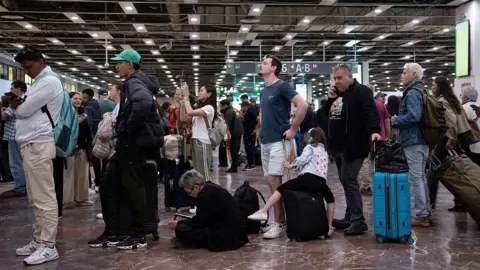Spain rules out cyber attack - but what could have caused power cut?
 Getty Images
Getty ImagesThe Spanish grid operator has ruled out a cyber attack as the cause of a massive power cut that crippled Spain, Portugal and parts of France on Monday.
Red Eléctrica's operations director Eduardo Prieto said preliminary findings suggest "there was no kind of interference in the control systems" to imply an attack, echoing Portuguese Prime Minister Luís Montenegro the day before.
But the exact reason behind the cut is still unclear.
The grid operator said on Tuesday they "cannot draw conclusions" until they get concrete data. Spain's Prime Minister Pedro Sánchez said investigators were trying to pinpoint the cause, and then would take all necessary measures "to ensure that this does not happen again."
Information is trickling out about what happened at the time of the cut, leading to theories about what could have caused it. Experts told the BBC it was likely caused by several failures.
Here is what we know and what questions remain unanswered.
Follow live: Travel chaos continues
Was the power cut caused by renewable energy?
Sánchez on Monday evening said 15GW of power - the equivalent to 60% of demand at that time - was "suddenly lost from the system... in just five seconds".
Mr Prieto said during a news conference on Tuesday that there were two "disconnection events" barely a second apart in the south-west of Spain, where there is substantial solar power generation.
One issue that the Spanish grid operator may have been referring to was when power companies identify a mismatch of supply and demand for electricity that could lead to instability, and disconnect temporarily in order to protect their systems.
However, Sánchez later said the power cut was "not a problem of excessive renewables". He said there was not a failure of coverage - meaning supply - and there was a relatively low demand for electricity that was quite normal in the days running up to the crisis.
So what exactly happened? It is unclear, especially as many systems fail in electricity supply quite frequently, not only renewables, and outages on this scale happen somewhere in the world around once a year on average.
The mismatch between supply and demand of electricity can change the frequency of the electricity grid, which is 50Hz in Europe and the UK.
If that frequency changes out of a narrow range, it could lead to damage to equipment.
"When a big company detects that the frequency is moving out of their tolerance, they can go offline to protect their equipment," said Prof Hannah Christensen at the University of Oxford.
If lots of companies do that in quick succession, it can have "cascading effects" and lead to a black-out, she added.
But when it comes to renewables, operators have very accurate short-term weather forecasts to predict when there will be a surplus of wind of solar power, so they adjust power supply accordingly, Prof Christensen said.
Renewable power has different challenges to fossil fuel energy "because of its intermittency", she said, but it is a well-known issue that is planned for.
"It is a little perplexing that this wouldn't have been predicted," she said.
Prof Keith Bell, at the University of Strathclyde, added that "if a system is relying on solar and wind, they design a system to reflect that," suggesting that the additional supply of energy from renewables will not have been a surprise to the grid.
"Spain has a lot of experience of wind and solar, and a long-standing system of forecasting weather and its impacts," he said.
"All sorts of systems fail," he added. "Things can and do go wrong, whether that is from renewables, fossil fuels or nuclear power. This could be the Swiss cheese model, where the holes in the system have happened to align."
Was it related to Spain's connection to France?
Red Eléctrica also suggested that the drop of power caused a grid interconnection between Spain and France to trip.
Two basic technologies are used to interconnect parts of a grid or countries - a standard transmission line that carries alternating currents, and increasingly, high voltage direct current lines.
Spain has a high voltage line that came into service seven years ago, meaning it is well-tested, Prof Bell said.
The Iberian peninsula is often referred to as an "electricity island" because it relies on just a few connections through the Pyrenees to France, meaning it can be vulnerable to failures.
Sánchez said power was brought back online thanks to connections with France and Morocco as well as gas and hydropower sources.
Was it linked to a 'rare atmospheric event'?
Portugal's grid operator REN refuted initial reports, attributed to the agency on Monday, which said the blackout was caused by a rare atmospheric event.
The message in Portuguese said that "due to extreme temperature variations in the interior or Spain, there were anomalous oscillations in the very high voltage lines (400 KV), a phenomenon known as 'induced atmospheric vibration'".
"These oscillations caused synchronisation failures between the electrical systems, leading to successive disturbances across the interconnected European network."
However, REN spokesman Bruno Silva told AFP on Tuesday that the grid operator "did not put out this statement," without giving further details.
